how do I invert the stationarity and reapply the dates to the data for plotting?
srcs:
- https://nbviewer.jupyter.org/github/robbiemu/location-metric-data/blob/master/appData%20and%20locationData.ipynb
- https://github.com/robbiemu/location-metric-data
I am trying to invert stationarity and get a plot of prediction, particularly for two columns called ' app_1', and ' app_2, (the orange and red lines below).
The data I am drawing from looks like this:

print(u1.info())
u1.head()
<class 'pandas.core.frame.DataFrame'>
DatetimeIndex: 15011 entries, 2017-08-28 11:00:00 to 2018-01-31 19:30:00
Freq: 15T
Data columns (total 10 columns):
app_1 15011 non-null float64
app_2 15011 non-null float64
user 15011 non-null object
bar 15011 non-null float64
grocers 15011 non-null float64
home 15011 non-null float64
lunch 15011 non-null float64
park 15011 non-null float64
relatives 15011 non-null float64
work 15011 non-null float64
dtypes: float64(9), object(1)
memory usage: 1.3+ MB
app_1 app_2 user bar grocers home lunch park relatives work
date
2017-08-28 11:00:00 0.010000 0.0 user_1 0.0 0.0 0.0 0.0 0.0 0.0 0.0
2017-08-28 11:15:00 0.010125 0.0 user_1 0.0 0.0 0.0 0.0 0.0 0.0 0.0
2017-08-28 11:30:00 0.010250 0.0 user_1 0.0 0.0 0.0 0.0 0.0 0.0 0.0
2017-08-28 11:45:00 0.010375 0.0 user_1 0.0 0.0 0.0 0.0 0.0 0.0 0.0
2017-08-28 12:00:00 0.010500 0.0 user_1 0.0 0.0 0.0 0.0 0.0 0.0 0.0
the location column represent a location the user is at at a given time -- after the first "significant location change" event, one and only one column will be a 1 at a time.
I am analyzing this with VARIMAX -- using statsmodels VARMAX version of AR.:
from statsmodels.tsa.statespace.varmax import VARMAX
import pandas as pd
import numpy as np
%matplotlib inline
import matplotlib
import matplotlib.pyplot as plt
from random import random
#...
columns = [ ' app_1', ' app_2', ' bar', ' grocers', ' home', ' lunch', ' work', ' park', ' relatives' ]
series = u1[columns]
# from: https://machinelearningmastery.com/make-predictions-time-series-forecasting-python/
# create a difference transform of the dataset
def difference(dataset):
diff = list()
for i in range(1, len(dataset)):
value = dataset[i] - dataset[i - 1]
diff.append(value)
return np.array(diff)
# Make a prediction give regression coefficients and lag obs
def predict(coef, history):
yhat = coef[0]
for i in range(1, len(coef)):
yhat += coef[i] * history[-i]
return yhat
X = pd.DataFrame()
for column in columns:
X[column] = difference(series[column].values)
size = (4*24)*54 # hoping
train, test = X[0:size], X[size:size+(14*4*24)]
train = train.loc[:, (train != train.iloc[0]).any()] # https://stackoverflow.com/questions/20209600/panda-dataframe-remove-constant-column
test = test.loc[:, (test != test.iloc[0]).any()] # https://stackoverflow.com/questions/20209600/panda-dataframe-remove-constant-column
#print(train.var(), X.info())
# train autoregression
model = VARMAX(train)
model_fit = model.fit(method='powell', disp=False)
#print(model_fit.mle_retvals)
##window = model_fit.k_ar
coef = model_fit.params
# walk forward over time steps in test
history = [train.iloc[i] for i in range(len(train))]
predictions = list()
for t in range(len(test)):
yhat = predict(coef, history)
obs = test.iloc[t]
predictions.append(yhat)
history.append(obs)
print(mean_squared_error(test, predictions))
0.5594208989876831
That mean_squared_error from scikitlearn is not horrifying (its roughly the middle of the three samples shown in the documentation, in fact). That _could mean that the data is predictive. I'd like to see that in a plot.
# plot
plt.plot(test)
plt.plot(predictions, color='red')
plt.show()
So, part of what is going on here is that the data is seasonal, so it had to have stationarity applied to it. Now the lines are all vertical, instead of temporal.
But another thing that concerns me is the scale of the red data. That's a lot of red. Anyway, how do I invert the stationarity and reapply the dates to the data for plotting? It obviously should not look like that. :)
